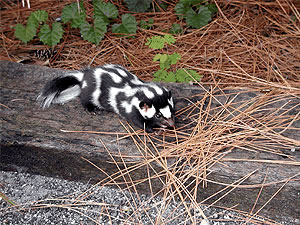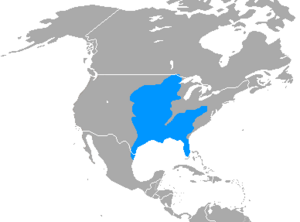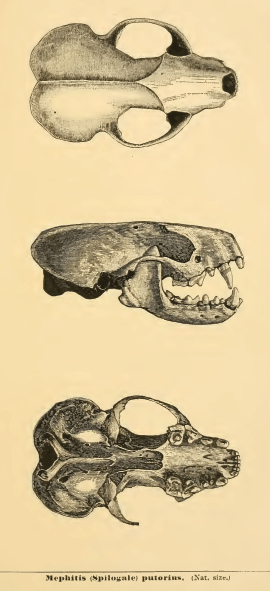Eastern spotted skunk facts for kids
Quick facts for kids Eastern spotted skunk |
|
|---|---|
 |
|
| Conservation status | |
| Scientific classification | |
| Genus: |
Spilogale
|
| Species: |
putorius
|
 |
|
|
range of Spilogale putorius
|
|
| Synonyms | |
|
Viverra putorius Linnaeus, 1758 |
|
The eastern spotted skunk (Spilogale putorius) is a small type of skunk. You can find it in North America, mostly in the central and southeastern United States. It also lives in small parts of Canada and Mexico.
This skunk is quite tiny, about the size of a large tree squirrel. It has a body shape that looks more like a weasel than the common striped skunk. The eastern spotted skunk has four broken white stripes on its back. These stripes make it look "spotted." It also has a white spot on its forehead.
Male skunks are a bit bigger than females. Males are usually about 46 to 69 cm (18 to 27 in) long, including their tail. Females are a bit smaller, around 35 to 54 cm (14 to 21 in) long. Their tail makes up about one-third of their total length. These skunks can weigh from 0.2 to 1.8 kg (0.44 to 3.97 lb). Males typically weigh about 700 g (1.5 lb), while females weigh around 450 g (0.99 lb).
Eastern spotted skunks are very active, more so than other skunks. They share their dens with up to eight other skunks in winter. They can also climb trees to find shelter. These skunks often live near forest edges and open grasslands. They especially like areas with rocks and bushes.
What Does It Look Like?
The eastern spotted skunk has a small, weasel-like body. Its fur is fine, dense, and black. It has 4 to 6 broken white stripes. Two stripes are in the middle of its body. Four more stripes run along its sides, from its head to its rear. It also has white markings on its cheeks and on the tip of its tail.
This pattern of black and white fur is called an aposematic pattern. It's like a warning sign to other animals. It tells predators, "Stay away! I can spray!"
A typical eastern spotted skunk is about 24 to 26 centimetres (9.4 to 10.2 in) long, not counting its tail. Its tail adds another 11 to 19 centimetres (4.3 to 7.5 in) to its length. So, their total length is about 35 to 45 centimetres (14 to 18 in). Their front claws are about 7 millimetres (0.28 in) long, and their back claws are around 3.5 centimetres (1.4 in) long. These large front claws help them dig and catch food. Their feet have special pads that help them climb.
How Do They Behave?
Eastern spotted skunks are shy and hard to spot. It's rare for people to see them. They are also nocturnal, meaning they are active at night. They prefer dry, cool nights over warm, wet ones.
Even though these skunks don't truly hibernate, they slow down a lot. This happens during very hot summers or very cold winters. Among the four types of spotted skunks, the eastern spotted skunk is the most active. They are also quicker and more alert than other skunks in North America.
When an eastern spotted skunk feels threatened, it does something amazing. It performs a handstand before spraying its stinky liquid! This is a unique warning. The skunk also stamps its feet on the ground. This foot stamping can be heard from several meters away. It's usually followed by the skunk spraying its strong-smelling defense.
If a skunk finds an egg it wants to eat, it has a clever trick. It will hold the egg with its front paws and try to bite it open. If that doesn't work, it will push the egg backward with its front paws. Then, it kicks the egg with one of its back legs to break it open!
Baby Skunks
Eastern spotted skunks usually have their babies in late May or early June. They typically breed in March or April. A female skunk usually gives birth to 4 or 5 baby skunks, called kits.
It takes about twelve weeks for newborn skunks to grow into young adults. They develop their special skunk musk for self-defense after about two months.
Why Are Their Numbers Declining?
The number of eastern spotted skunks has dropped sharply in many states. This is especially true in the Midwest, like Minnesota and Wisconsin. Scientists are not entirely sure why this is happening. It's a bit puzzling because these skunks used to adapt well to living near people. They were even commonly trapped for their fur until the mid-1900s.
In the past, these skunks were often seen on farms. They would dig burrows under barns and hunt mice that were attracted to stored grains. But after 1949, the number of trapped skunks in Minnesota fell quickly.
Many things are thought to have caused this decline. These include the use of Pesticides, new farming methods, and too much trapping. Also, old barns and farm buildings, which were important habitats, are now less common. Because of these changes, the eastern spotted skunk might have disappeared from some Midwestern states. Overall, their numbers are going down in that area. They are also declining in parts of the eastern US, like Pennsylvania.
Where their numbers are not dropping, the eastern spotted skunk is still uncommon. However, they remain common in Southern Florida. Studies have shown that in some areas, like the Carolinas and Virginia, their numbers have continued to fall. Predators like owls are a big reason for this. Also, diseases, like a canine distemper outbreak, have sadly killed many skunks in some places.





